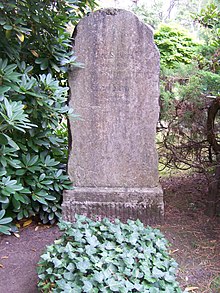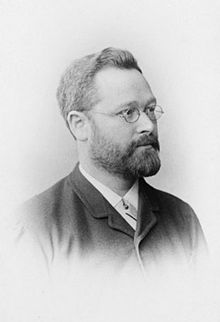Eduard Sievers
Eduard Georg Sievers (born November 25, 1850 in Lippoldsberg , Hofgeismar district , † March 30, 1932 in Leipzig ) was a German Germanic Medievalist and linguist ( young grammarist ). He was a professor at the universities in Jena , Tübingen , Halle and Leipzig .
Life
After graduating from the Lyceum Fridericianum in Kassel, Sievers studied classical philology, German and English at the universities of Leipzig and Berlin from 1867 to 1870. In 1870 he received his doctorate at the University of Leipzig with the dissertation "Investigations on Tatian " for Dr. phil. After research stays in Oxford and London, where he studied Old English manuscripts, he was appointed Associate Professor of German Philology at the University of Jena in 1871 . In 1876 he was appointed full professor . Sievers followed a call to the University of Tübingen in 1883 , and in 1887 he moved to the United Friedrichs University of Halle-Wittenberg . From 1892 until his retirement in 1922 he held a chair for German philology at the Philosophical Faculty of the University of Leipzig. In the academic year 1899/1900 Sievers was dean of the Philosophical Faculty, in the academic year 1901/1902 rector of the University of Leipzig.
He had been a member of the Leipzig fraternity of Plessavia since the summer semester of 1895. Since 1889 he was a corresponding member of the Bavarian and since 1892 a full member of the Saxon Academy of Sciences . In 1900 he was accepted as a corresponding member of the Prussian Academy of Sciences . In 1920 he was elected a foreign member of the Göttingen Academy of Sciences .
plant

Sievers gained international attention through his rhythmic-melodic studies (1912), in which he explored melody in spoken language. Supported by experiments with test subjects, he proposes the thesis that literary texts are given a melody consciously or unconsciously inserted by the author, which is reproduced in a similar way for most readers.
The Sieversche law , a Germanic / Indo-European sound law , was named after him.
Sievers is important for quantitative linguistics because, as one of the forerunners of the Menzerath-Altmann law, he paved the way and carried out statistical surveys on literary works.
Fonts
- Investigations on Tatian , printing press of the orphanage, Halle 1870 (dissertation).
- The Heliand and the Anglo-Saxon Genesis , Lippert (Niemeyer), Halle / S. 1875.
- Samples of a metric production of the Edda songs, Fues, Tübingen 1885.
- Tübingen fragments of the older Frostuthingslög, Tübingen 1886.
- Old Germanic metrics , Niemeyer, Halle 1893.
- Outline of the Anglo-Saxon grammar , Niemeyer, Halle as 1895 (16th edition 1963).
- with Elias Steinmeyer (Ed.): The Old High German Glosses. IV, Berlin 1879-1922; Reprinted Dublin and Zurich 1969.
- Basics of phonetic physiology as an introduction to the study of phonetics in the Indo-European languages. Breitkopf & Härtel, Leipzig 1876. (Another 4 editions 1881, 1885, 1893 and 1901 under the title Principles of Phonetics for an Introduction to the Study of Phonology of the Indo-European Languages at the same publisher)
- On Anglo-Saxon vocalism , Edelmann, Leipzig 1900.
- Runes and runic inscriptions. In: Hermann Paul (Hrsg.): Grundriss der Germanischen Philologie. First volume. Second improved and enlarged edition. Trübner, Strassburg 1901, pp. 248-262.
- Metric studies , three parts, Teubner, Leipzig 1903–1919.
- Old Testament miscelles, ten parts, Leipzig 1904–1907.
- Rhythmic-melodic studies. Lectures and essays. Winter, Heidelberg 1912.
- The old Swedish Upplandslagh along with samples of similar Germanic sagas , two parts, Teubner, Leipzig 1919.
- H. Lietzmann and the sound analysis. A criticism and a self-criticism , Hinrichs, Leipzig 1921.
- Publisher: Der Nibelunge Nôt / Kûdrûn ( Middle High German edition, " Libri Librorum " series), Insel Verlag, Leipzig 1921
- Goals and ways of sound analysis. Two lectures , Winter, Heidelberg 1924.
- Old Slavic ē and yes. A study of the history of language , Hirzel, Leipzig 1925.
- New contributions to the theory of case intonation , Hirzel, Leipzig 1930.
- To the English history of sounds. Critical investigations , Hirzel, Leipzig 1930.
- Anglo-Saxon grammar , BiblioBazaar 2009
literature
- Karl-Heinz Best : Eduard Sievers (1850–1932). In: Glottometrics. 18, 2009, ISSN 1617-8351 , pp. 87-91 (PDF full text ). (Reprinted in: Karl-Heinz Best (Hrsg.): Studies on the History of Quantitative Linguistics. Volume 1. RAM-Verlag, Lüdenscheid 2015, pp. 146–150. ISBN 978-3-942303-30-9 .)
- Eveline Einhauser: Sievers, Eduard (1850–1932). In: Keith Brown (Ed.): Encyclopedia of language and linguistics. 2nd Edition. Elsevier, Oxford 2006, ISBN 0-08-044299-4 , pp. 288-290.
- Germanica. Eduard Sievers on his 75th birthday, November 25, 1925 , Niemeyer, Halle (Saale) 1925.
- Eckhard Meineke: The linguist Eduard Sievers and the foundation of the German seminar in Jena. In: Reinhard Hahn, Angelika Pöthe (Ed.): “... and what kind of fights there were.” Studies on the history of German studies at the University of Jena. Winter, Heidelberg 2010, ISBN 978-3-8253-5648-4 , pp. 99-118.
- Philological Studies. Ceremony for Eduard Sievers on October 1, 1896, Niemeyer, Halle (Saale) 1896.
- Hans-Joachim Solms: Sievers, Georg Eduard. In: New German Biography (NDB). Volume 24, Duncker & Humblot, Berlin 2010, ISBN 978-3-428-11205-0 , p. 390 f. ( Digitized version ).
Web links
- Literature by and about Eduard Sievers in the catalog of the German National Library
- Overview of Eduard Sievers' courses at the University of Leipzig (summer semester 1892 to summer semester 1914)
- Eduard Sievers in the professorial catalog of the University of Leipzig
- Entry on Eduard Sievers in the Catalogus Professorum Halensis
- Member of the Royal Saxon Society of Sciences in Leipzig
Individual evidence
- ^ Eduard Sievers in the professorial catalog of the University of Leipzig
- ↑ Holger Krahnke: The members of the Academy of Sciences in Göttingen 1751-2001 (= Treatises of the Academy of Sciences in Göttingen, Philological-Historical Class. Volume 3, Vol. 246 = Treatises of the Academy of Sciences in Göttingen, Mathematical-Physical Class. Episode 3, vol. 50). Vandenhoeck & Ruprecht, Göttingen 2001, ISBN 3-525-82516-1 , p. 226.
| personal data | |
|---|---|
| SURNAME | Sievers, Eduard |
| ALTERNATIVE NAMES | Sievers, Eduard Georg (full name) |
| BRIEF DESCRIPTION | German medievalist and linguist (young grammarist) |
| DATE OF BIRTH | November 25, 1850 |
| PLACE OF BIRTH | Lippoldsberg |
| DATE OF DEATH | March 30, 1932 |
| Place of death | Leipzig |
